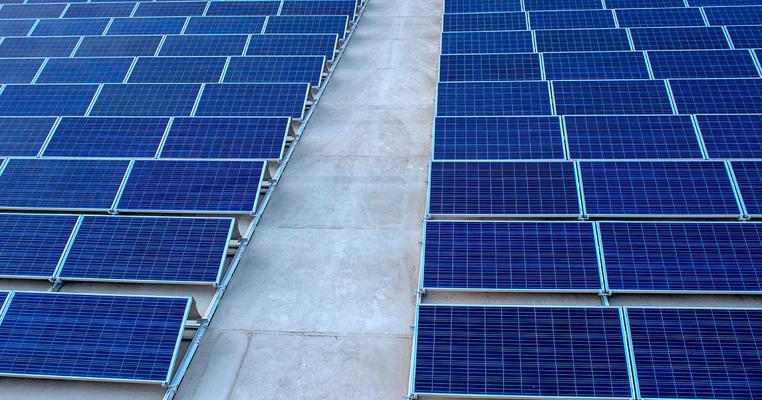
How are solar panels made anyway?
Despite the tremendous source of energy shining in the sky, deniers keep debating and downplaying the merits of solar power and other renewable energies, asking the same questions over and over again: How effective is solar energy? Isn’t it more expensive? What happens when the sun goes down or it’s cloudy?
We’ve busted those myths before, but a question we always get is a sheepish, OK, but what are solar panels made of and are we hurting the climate by creating them?
No need to be sheepish. It’s a bit complicated!
First, there’s the panel itself.
The large black solar panels you see on homes and businesses are made of a bunch of solar cells (or photovoltaic cells) made of silicon semiconductors that absorb sunlight and create an electric current. These individual cells are connected together to make one solar panel.
If you want to get even more technical, you can look at the structure of these individual solar cells. They’re made of two types of semiconductors: a positive (p-type) and a negative (n-type) silicon layers.
While the n-type silicon layer has extra electrons which can move around relatively freely, the p-type layer has electron vacancies referred to as holes. When you bring the layers together, electrons begin to move from the n-type to the p-type which forms a special junction and produces electric potential in the material. When sunlight hits this junction, the photon can knock an electron free and leaves behind a hole. As more electrons fill the newly created holes, the free electrons begin to collect at the pole. The collected electrons then flow through a conductor and an electric current is produced.
Why silicon?
In the 1940s, a researcher at Bell Labs named Russell Ohl discovered the functionality of the P-N junction and that that silicon – an element found in sand and the second most abundant element in the Earth's crust after oxygen – exhibited properties that were conducive to the formation of this junction.
Scientists continued to work and build on Ohl’s discovery, and in 1954, Bell Labs unveiled the first modern solar cell.
The demonstration inspired a 1954 New York Times article to predict that solar cells would eventually lead "to the realization of one of mankind's most cherished dreams -- the harnessing of the almost limitless energy of the sun.''
Nowadays, photovoltaic (PV) cells are mostly mass-produced and cut by lasers – a far cry from their humble origins.
Next, there’s the inverter. The solar cells collect the sun’s energy and turn it into direct current (DC) electricity. Most homes and businesses, however, use alternating current (AC). Inverters change the DC electricity from solar panels into usable AC electricity.
Finally, there’s the mounting system to keep the whole thing on a roof or secured safely to the ground. Generally, in the northern hemisphere, solar panels should face south and be installed at a 30- or 45-degree angle, depending on the distance from the equator. Fixed mounts keep the panels in place, but track mounts that “follow” the sun throughout the day are also available, although usually more expensive.
OK, so how green is all of this?
Yes, it's true that manufacturing solar panels creates carbon dioxide, like the manufacturing of most things. There's also some legitimate concern about solar panel disposal.
But as solar panel manufacturing becomes more efficient, its carbon footprint has been shrinking significantly. A 2016 study reports that the overall emissions produced decreased by 17 to 24 percent every time install capacity has doubled in the last 40 years.
And the overall greenhouse gas emissions involved in solar energy is still (unsurprisingly) much lower than coal or natural gas. Solar panels themselves can last for decades without much upkeep – and because their parts don’t wear out easily, PV panels are well-known to continue producing clean electricity well beyond their often-lengthy warranties, though sometimes at slightly less efficiency as the years fade from one to the next.
At the end of the life for a panel, some manufacturers offer global recycling programs for their customers.
A June 2012 National Renewable Energy Laboratory (NREL) study investigating the photovoltaic degradation rates of about 2,000 solar installations over a period of 40 years found the median solar system lost just 0.5 percent of its power output per year. So, by the end of a typical 25-year warranty, the solar panels on your roof could still be operating at about 87 percent of their original capacity.
Plus, with the rising popularity of solar, recycling programs and companies are expected to grow and become more robust in the future.
Learn even more about the benefits of solar energy by downloading our free e-book, Things Are Looking Bright: The Facts about Solar Energy or checking out Knowledge is Power, our collaboration with HGTV’s Property Brothers co-host and solar energy advocate Jonathan Scott.
The e-book talks about the incredible benefits of solar energy and the deceptive tactics fossil fuel utilities are using to protect their bottom lines at the expense of every person on the planet.

